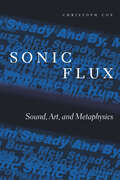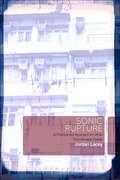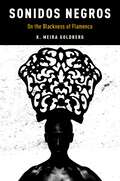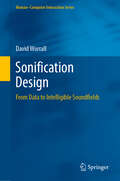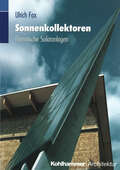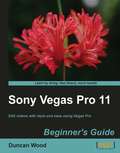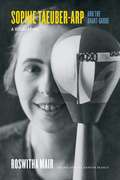- Table View
- List View
Sonic Flux: Sound, Art, and Metaphysics
by Christoph CoxFrom Edison’s invention of the phonograph through contemporary field recording and sound installation, artists have become attracted to those domains against which music has always defined itself: noise, silence, and environmental sound. Christoph Cox argues that these developments in the sonic arts are not only aesthetically but also philosophically significant, revealing sound to be a continuous material flow to which human expressions contribute but which precedes and exceeds those expressions. Cox shows how, over the course of the twentieth and twenty-first centuries, philosophers and sonic artists have explored this “sonic flux.” Through the philosophical analysis of works by John Cage, Maryanne Amacher, Max Neuhaus, Christian Marclay, and many others, Sonic Flux contributes to the development of a materialist metaphysics and poses a challenge to the prevailing positions in cultural theory, proposing a realist and materialist aesthetics able to account not only for sonic art but for artistic production in general.
Sonic Flux: Sound, Art, and Metaphysics
by Christoph CoxFrom Edison’s invention of the phonograph through contemporary field recording and sound installation, artists have become attracted to those domains against which music has always defined itself: noise, silence, and environmental sound. Christoph Cox argues that these developments in the sonic arts are not only aesthetically but also philosophically significant, revealing sound to be a continuous material flow to which human expressions contribute but which precedes and exceeds those expressions. Cox shows how, over the course of the twentieth and twenty-first centuries, philosophers and sonic artists have explored this “sonic flux.” Through the philosophical analysis of works by John Cage, Maryanne Amacher, Max Neuhaus, Christian Marclay, and many others, Sonic Flux contributes to the development of a materialist metaphysics and poses a challenge to the prevailing positions in cultural theory, proposing a realist and materialist aesthetics able to account not only for sonic art but for artistic production in general.
Sonic Flux: Sound, Art, and Metaphysics
by Christoph CoxFrom Edison’s invention of the phonograph through contemporary field recording and sound installation, artists have become attracted to those domains against which music has always defined itself: noise, silence, and environmental sound. Christoph Cox argues that these developments in the sonic arts are not only aesthetically but also philosophically significant, revealing sound to be a continuous material flow to which human expressions contribute but which precedes and exceeds those expressions. Cox shows how, over the course of the twentieth and twenty-first centuries, philosophers and sonic artists have explored this “sonic flux.” Through the philosophical analysis of works by John Cage, Maryanne Amacher, Max Neuhaus, Christian Marclay, and many others, Sonic Flux contributes to the development of a materialist metaphysics and poses a challenge to the prevailing positions in cultural theory, proposing a realist and materialist aesthetics able to account not only for sonic art but for artistic production in general.
Sonic Flux: Sound, Art, and Metaphysics
by Christoph CoxFrom Edison’s invention of the phonograph through contemporary field recording and sound installation, artists have become attracted to those domains against which music has always defined itself: noise, silence, and environmental sound. Christoph Cox argues that these developments in the sonic arts are not only aesthetically but also philosophically significant, revealing sound to be a continuous material flow to which human expressions contribute but which precedes and exceeds those expressions. Cox shows how, over the course of the twentieth and twenty-first centuries, philosophers and sonic artists have explored this “sonic flux.” Through the philosophical analysis of works by John Cage, Maryanne Amacher, Max Neuhaus, Christian Marclay, and many others, Sonic Flux contributes to the development of a materialist metaphysics and poses a challenge to the prevailing positions in cultural theory, proposing a realist and materialist aesthetics able to account not only for sonic art but for artistic production in general.
Sonic Flux: Sound, Art, and Metaphysics
by Christoph CoxFrom Edison’s invention of the phonograph through contemporary field recording and sound installation, artists have become attracted to those domains against which music has always defined itself: noise, silence, and environmental sound. Christoph Cox argues that these developments in the sonic arts are not only aesthetically but also philosophically significant, revealing sound to be a continuous material flow to which human expressions contribute but which precedes and exceeds those expressions. Cox shows how, over the course of the twentieth and twenty-first centuries, philosophers and sonic artists have explored this “sonic flux.” Through the philosophical analysis of works by John Cage, Maryanne Amacher, Max Neuhaus, Christian Marclay, and many others, Sonic Flux contributes to the development of a materialist metaphysics and poses a challenge to the prevailing positions in cultural theory, proposing a realist and materialist aesthetics able to account not only for sonic art but for artistic production in general.
Sonic Flux: Sound, Art, and Metaphysics
by Christoph CoxFrom Edison’s invention of the phonograph through contemporary field recording and sound installation, artists have become attracted to those domains against which music has always defined itself: noise, silence, and environmental sound. Christoph Cox argues that these developments in the sonic arts are not only aesthetically but also philosophically significant, revealing sound to be a continuous material flow to which human expressions contribute but which precedes and exceeds those expressions. Cox shows how, over the course of the twentieth and twenty-first centuries, philosophers and sonic artists have explored this “sonic flux.” Through the philosophical analysis of works by John Cage, Maryanne Amacher, Max Neuhaus, Christian Marclay, and many others, Sonic Flux contributes to the development of a materialist metaphysics and poses a challenge to the prevailing positions in cultural theory, proposing a realist and materialist aesthetics able to account not only for sonic art but for artistic production in general.
Sonic Rupture: A Practice-led Approach to Urban Soundscape Design
by Jordan LaceySonic Rupture applies a practitioner-led approach to urban soundscape design, which foregrounds the importance of creative encounters in global cities. This presents an alternative to those urban soundscape design approaches concerned with managing the negative health impacts of noise. Instead, urban noise is considered to be a creative material and cultural expression that can be reshaped with citywide networks of sonic installations. By applying affect theory the urban is imagined as an unfolding of the Affective Earth, and noise as its homogenous (and homogenizing) voice. It is argued that noise is an expressive material with which sonic practitioners can interface, to increase the creative possibilities of urban life. At the heart of this argument is the question of relationships: how do we augment and diversify those interconnections that weave together the imaginative life and the expressions of the land? The book details seven sound installations completed by the author as part of a creative practice research process, in which the sonic rupture model was discovered. The sonic rupture model, which aims to diversify human experiences and urban environments, encapsulates five soundscape design approaches and ten practitioner intentions. Multiple works of international practitioners are explored in relation to the discussed approaches. Sonic Rupture provides the domains of sound art, music, creative practice, urban design, architecture and environmental philosophy with a unique perspective for understanding those affective forces, which shape urban life. The book also provides a range of practical and conceptual tools for urban soundscape design that can be applied by the sonic practitioner.
Sonic Rupture: A Practice-led Approach to Urban Soundscape Design
by Jordan LaceySonic Rupture applies a practitioner-led approach to urban soundscape design, which foregrounds the importance of creative encounters in global cities. This presents an alternative to those urban soundscape design approaches concerned with managing the negative health impacts of noise. Instead, urban noise is considered to be a creative material and cultural expression that can be reshaped with citywide networks of sonic installations. By applying affect theory the urban is imagined as an unfolding of the Affective Earth, and noise as its homogenous (and homogenizing) voice. It is argued that noise is an expressive material with which sonic practitioners can interface, to increase the creative possibilities of urban life. At the heart of this argument is the question of relationships: how do we augment and diversify those interconnections that weave together the imaginative life and the expressions of the land? The book details seven sound installations completed by the author as part of a creative practice research process, in which the sonic rupture model was discovered. The sonic rupture model, which aims to diversify human experiences and urban environments, encapsulates five soundscape design approaches and ten practitioner intentions. Multiple works of international practitioners are explored in relation to the discussed approaches. Sonic Rupture provides the domains of sound art, music, creative practice, urban design, architecture and environmental philosophy with a unique perspective for understanding those affective forces, which shape urban life. The book also provides a range of practical and conceptual tools for urban soundscape design that can be applied by the sonic practitioner.
Sonidos Negros: On the Blackness of Flamenco (Currents in Latin American and Iberian Music)
by K. Meira GoldbergHow is the politics of Blackness figured in the flamenco dancing body? What does flamenco dance tell us about the construction of race in the Atlantic world? Sonidos Negros traces how, in the span between 1492 and 1933, the vanquished Moor became Black, and how this figure, enacted in terms of a minstrelized Gitano, paradoxically came to represent Spain itself. The imagined Gypsy about which flamenco imagery turns dances on a knife's edge delineating Christian and non-Christian, White and Black worlds. This figure's subversive teetering undermines Spain's symbolic linkage of religion with race, a prime weapon of conquest. Flamenco's Sonidos Negros live in this precarious balance, amid the purposeful confusion and ruckus cloaking embodied resistance, the lament for what has been lost, and the values and aspirations of those rendered imperceptible by enslavement and colonization.
SONIDOS NEGROS ON BLACKN OF FLAM CILAM C: On the Blackness of Flamenco (Currents in Latin American and Iberian Music)
by K. Meira GoldbergHow is the politics of Blackness figured in the flamenco dancing body? What does flamenco dance tell us about the construction of race in the Atlantic world? Sonidos Negros traces how, in the span between 1492 and 1933, the vanquished Moor became Black, and how this figure, enacted in terms of a minstrelized Gitano, paradoxically came to represent Spain itself. The imagined Gypsy about which flamenco imagery turns dances on a knife's edge delineating Christian and non-Christian, White and Black worlds. This figure's subversive teetering undermines Spain's symbolic linkage of religion with race, a prime weapon of conquest. Flamenco's Sonidos Negros live in this precarious balance, amid the purposeful confusion and ruckus cloaking embodied resistance, the lament for what has been lost, and the values and aspirations of those rendered imperceptible by enslavement and colonization.
Sonification Design: From Data to Intelligible Soundfields (Human–Computer Interaction Series)
by David WorrallThe contemporary design practice known as data sonification allows us to experience information in data by listening. In doing so, we understand the source of the data in ways that support, and in some cases surpass, our ability to do so visually. In order to assist us in negotiating our environments, our senses have evolved differently. Our hearing affords us unparalleled temporal and locational precision. Biological survival has determined that the ears lead the eyes. For all moving creatures, in situations where sight is obscured, spatial auditory clarity plays a vital survival role in determining both from where the predator is approaching or to where the prey has escaped. So, when designing methods that enable listeners to extract information from data, both with and without visual support, different approaches are necessary. A scholarly yet approachable work by one of the recognized leaders in the field of auditory design, this book will - Lead you through some salient historical examples of how non-speech sounds have been used to inform and control people since ancient times. - Comprehensively summarize the contemporary practice of Data Sonification. - Provide a detailed overview of what information is and how our auditory perceptions can be used to enhance our knowledge of the source of data. - Show the importance of the dynamic relationships between hearing, cognitive load, comprehension, embodied knowledge and perceptual truth. - Discuss the role of aesthetics in the dynamic interplay between listenability and clarity. - Provide a mature software framework that supports the practice of data sonification design, together with a detailed discussion of some of the design principles used in various examples. David Worrall is an internationally recognized composer, sound artist and interdisciplinary researcher in the field of auditory design. He is Professor of Audio Arts and Acoustics at Columbia College Chicago and a former elected president of the International Community for Auditory Display (ICAD), the leading organization in the field since its inception over 25 years ago.Code and audio examples for this book are available athttps://github.com/david-worrall/springer/ Here is an excellent review of the book by Dr Gregory Kramer: “Worrall proceeds bravely through the trees and vines of philosophy, information theory, aesthetics, and other contributors to sonification design theory. It’s a feat. He nails all of this down with the specific implementation system he’s designed over many years, and applies his theories to specific problems. In a field of research still in its first half century and setting its bearings in a world where human perception has become a sideshow to machine learning, deep learning, and artificial intelligence, the roots David provides will serve well.” Dr Gregory Kramer is the founding figure in the emerging field of sonification, founded the International Conference on Auditory Display (ICAD) and editor of the first book in the field, "Auditory Display: Sonification, Audification and Auditory Interfaces" (Addison Wesley, 1994).
Sonnenkollektoren: Thermische Solaranlagen
by Ulrich FoxAls Planungshilfe für Architekten und Bauherrn vermittelt das Buch grundlegende Informationen über Kollektorbauarten, Dimensionierung, Installation, Steuerung und Speicherungssysteme. An zahlreichen Beispielen wird die Integration der Solarsysteme in die Dachgestaltung und Gebäudearchitektur dargestellt und erläutert. Ein spezielles Kapitel geht auf die aktuellen Fördermaßnahmen und bestehenden Fördermittel ein.
Sons Without Fathers: A New Version of Chekhov's Platonov (Oberon Modern Plays)
by Anton Chekhov Helena Kaut-HowsonToo old to move with the times; too young to let go of their dreams.Village schoolteacher Platonov is a man who is loved by women. Despite his best intentions he is drawn into a series of extramarital affairs that all hold the promise of escape from the provincial reality where he and his circle of friends are trapped. Consumed by bitterness and disappointment, they attempt to fill the void in their lives with sex and vodka, blaming their fathers for the mess they’ve been left in.Sons Without Fathers is a brand-new adaptation of Chekhov’s remarkable first play. Helena Kaut-Howson’s version chooses to focus on just one of the many themes covered in the original text – the predicament of a disaffected generation left adrift in a world without hope. Updated to modern-day Russia, the play intertwines the central story with contemporary political issues.
Sony Alpha SLT-A35 / A55 For Dummies
by Robert CorrellA practical, step-by-step guide to Sony's most popular new dSLRs Sony's new a35 and a55 camera models offer a full range of dSLR features, including pre-sets and auto modes for beginners as well as full manual control over exposure and a unique translucent mirror option. This friendly For Dummies guide gets new dSLR users up to speed and helps more experienced photographers take full advantage of the many options these cameras offer. It covers all the basic camera controls and explains how to set up shooting modes, shoot video, master exposure and focus, edit images, and more. Sony's a35 and a55 models offer a full range of dSLR features and a translucent mirror option, this guide helps new and experienced photographers take full advantage of them all Covers setting up the camera, using all the basic and advanced controls, using auto mode, and shooting video Explores controls that handle exposure, flash, focus, and color, and how to make these elements work to create a great photo Explains image playback, review, and basic editing Sony a35/a55 For Dummies gets you up and running with your new Sony dSLR quickly and helps you make the most of everything it has to offer.
Sony Alpha SLT-A35 / A55 For Dummies
by Robert CorrellA practical, step-by-step guide to Sony's most popular new dSLRs Sony's new a35 and a55 camera models offer a full range of dSLR features, including pre-sets and auto modes for beginners as well as full manual control over exposure and a unique translucent mirror option. This friendly For Dummies guide gets new dSLR users up to speed and helps more experienced photographers take full advantage of the many options these cameras offer. It covers all the basic camera controls and explains how to set up shooting modes, shoot video, master exposure and focus, edit images, and more. Sony's a35 and a55 models offer a full range of dSLR features and a translucent mirror option, this guide helps new and experienced photographers take full advantage of them all Covers setting up the camera, using all the basic and advanced controls, using auto mode, and shooting video Explores controls that handle exposure, flash, focus, and color, and how to make these elements work to create a great photo Explains image playback, review, and basic editing Sony a35/a55 For Dummies gets you up and running with your new Sony dSLR quickly and helps you make the most of everything it has to offer.
Sony Alpha SLT-A65 / A77 For Dummies
by Robert CorrellJust what you need to get up and running with Sony's new flagship dSLRs The Sony a77, with its 24.3 megapixel sensor, full HD video capability, and translucent mirror system, is poised to be Sony's flagship dSLR camera. With many of the same features but at a lower price point, the a65 is the economy version. This guide will cover all the important steps for getting the most from either model. It shows how to set up the camera to get great shots immediately, explains all the controls and shooting modes, shows how to review images and make basic edits, and offers valuable advice on taking super photos using manual settings. Sony's new a65 and a77 dSLRs feature a huge megapixel sensor, HD video, generous ISO range, and the translucent mirror system unique to Sony This easy-to-follow guide helps you make the most of your investment with complete coverage of all the basic and advanced settings and shooting modes Covers shooting in auto mode, shooting HD video, and taking manual control over exposure, focus, and lighting Explains how to play back images and perform basic edits as well as how to manipulate flash, focus, and color to create top-quality photos With Sony a65/a77 For Dummies, bestselling photography author Robert Correll gives new Sony dSLR users confidence and helps them get everything they paid for in these exciting new Sony camera models.
Sony Alpha SLT-A65 / A77 For Dummies
by Robert CorrellJust what you need to get up and running with Sony's new flagship dSLRs The Sony a77, with its 24.3 megapixel sensor, full HD video capability, and translucent mirror system, is poised to be Sony's flagship dSLR camera. With many of the same features but at a lower price point, the a65 is the economy version. This guide will cover all the important steps for getting the most from either model. It shows how to set up the camera to get great shots immediately, explains all the controls and shooting modes, shows how to review images and make basic edits, and offers valuable advice on taking super photos using manual settings. Sony's new a65 and a77 dSLRs feature a huge megapixel sensor, HD video, generous ISO range, and the translucent mirror system unique to Sony This easy-to-follow guide helps you make the most of your investment with complete coverage of all the basic and advanced settings and shooting modes Covers shooting in auto mode, shooting HD video, and taking manual control over exposure, focus, and lighting Explains how to play back images and perform basic edits as well as how to manipulate flash, focus, and color to create top-quality photos With Sony a65/a77 For Dummies, bestselling photography author Robert Correll gives new Sony dSLR users confidence and helps them get everything they paid for in these exciting new Sony camera models.
Sony Vegas Pro 11 Beginner's Guide
by Duncan WoodThe book takes a clear, step-by-step approach to guide you through the process creating a video project with Vegas Pro. With each chapter, you will "level up" your video editing skills,Are you keen on creating professional quality videos? You know little or nothing about video editing and Vegas Pro? Then this book is a perfect fit for you to dive headfirst into video production with Vegas Pro.
Sophia Robot: Post Human Being (ISSN)
by Thomas RiccioThis book considers David Hanson’s robots as a performative expression of our cultural moment, serving as a paradigm for the evolution of humanoid social robots.Mechanical beings have occupied the human imagination since antiquity. Now, they inhabit the pop-cultural imagination, embodying the apotheosis of humanity’s technological aspirations and dread. Sophia, Hanson’s most advanced robot, anticipates the future as she articulates the mythic pattern, narrative, anxieties, and hopes as old as humanity. Gendered as an attractive female with a face inspired by Queen Nefertiti and Audrey Hepburn, Sophia is a cipher, avatar, and turning point that brings humanity and technology a step closer to the emergence of a post-human species. The author is a transdisciplinary artist/scholar/educator working internationally in experimental performance, indigenous performance (ritual, shamanism), and social robotics. Hanson’s robots and Sophia are examined as performance media and events, as characters evolving as post-human narratives of technological beings. The emergent, complex, and collaborative relationships social robots have with technology, AI, performance, anthropology, mythology, psychology, sociology, popular culture, social media, politics, and economics are considered.
Sophia Robot: Post Human Being (ISSN)
by Thomas RiccioThis book considers David Hanson’s robots as a performative expression of our cultural moment, serving as a paradigm for the evolution of humanoid social robots.Mechanical beings have occupied the human imagination since antiquity. Now, they inhabit the pop-cultural imagination, embodying the apotheosis of humanity’s technological aspirations and dread. Sophia, Hanson’s most advanced robot, anticipates the future as she articulates the mythic pattern, narrative, anxieties, and hopes as old as humanity. Gendered as an attractive female with a face inspired by Queen Nefertiti and Audrey Hepburn, Sophia is a cipher, avatar, and turning point that brings humanity and technology a step closer to the emergence of a post-human species. The author is a transdisciplinary artist/scholar/educator working internationally in experimental performance, indigenous performance (ritual, shamanism), and social robotics. Hanson’s robots and Sophia are examined as performance media and events, as characters evolving as post-human narratives of technological beings. The emergent, complex, and collaborative relationships social robots have with technology, AI, performance, anthropology, mythology, psychology, sociology, popular culture, social media, politics, and economics are considered.
Sophie Calle (PDF)
by Andrea Tarsia with Hannah Vaughan and Candy StobbsSophie Calle: The Reader provides a critical tool for navigating Sophie Calle's image and text work from 1979 to the present, bringing together interviews with the artist, critical commentaries by an international range of critics, curators, artists and art historians and an index summarising recurrent themes. The Reader is arranged chronologically charting Sophie Calle's earliest work, beginning with The Sleepers, 1979 to Take Care of Yourself, 2007 and Berck, 2008.
Sophie Taeuber-Arp and the Avant-Garde: A Biography
by Roswitha MairSophie Taeuber-Arp was a quiet innovator whose fame has too often been yoked to that of her husband, Jean Arp. Over time, however, she has slowly come to be seen as one of the foremost abstract artists and designers of the twentieth century. The Swiss-born Taeuber-Arp had a front row seat to the first wave of Dadaism and was, along with Mondrian and Malevich, a pioneer of Constructivism. Her singular artwork incorporated painting, sculpture, dance, fiber arts, and architecture, as hers was one of the first oeuvres to successfully bridge the divide between fine and functional art. Now Roswitha Mair has brought us the first biography of this unique polymath, illuminating not just Tauber-Arp’s own life and work, but also the various milieux and movements in which she traveled. No fan of the Dadaists and their legacy will want to miss this first English-language translation.
Sophie Taeuber-Arp and the Avant-Garde: A Biography
by Roswitha MairSophie Taeuber-Arp was a quiet innovator whose fame has too often been yoked to that of her husband, Jean Arp. Over time, however, she has slowly come to be seen as one of the foremost abstract artists and designers of the twentieth century. The Swiss-born Taeuber-Arp had a front row seat to the first wave of Dadaism and was, along with Mondrian and Malevich, a pioneer of Constructivism. Her singular artwork incorporated painting, sculpture, dance, fiber arts, and architecture, as hers was one of the first oeuvres to successfully bridge the divide between fine and functional art. Now Roswitha Mair has brought us the first biography of this unique polymath, illuminating not just Tauber-Arp’s own life and work, but also the various milieux and movements in which she traveled. No fan of the Dadaists and their legacy will want to miss this first English-language translation.
Sophie Taeuber-Arp and the Avant-Garde: A Biography
by Roswitha MairSophie Taeuber-Arp was a quiet innovator whose fame has too often been yoked to that of her husband, Jean Arp. Over time, however, she has slowly come to be seen as one of the foremost abstract artists and designers of the twentieth century. The Swiss-born Taeuber-Arp had a front row seat to the first wave of Dadaism and was, along with Mondrian and Malevich, a pioneer of Constructivism. Her singular artwork incorporated painting, sculpture, dance, fiber arts, and architecture, as hers was one of the first oeuvres to successfully bridge the divide between fine and functional art. Now Roswitha Mair has brought us the first biography of this unique polymath, illuminating not just Tauber-Arp’s own life and work, but also the various milieux and movements in which she traveled. No fan of the Dadaists and their legacy will want to miss this first English-language translation.
Sophie Taeuber-Arp and the Avant-Garde: A Biography
by Roswitha MairSophie Taeuber-Arp was a quiet innovator whose fame has too often been yoked to that of her husband, Jean Arp. Over time, however, she has slowly come to be seen as one of the foremost abstract artists and designers of the twentieth century. The Swiss-born Taeuber-Arp had a front row seat to the first wave of Dadaism and was, along with Mondrian and Malevich, a pioneer of Constructivism. Her singular artwork incorporated painting, sculpture, dance, fiber arts, and architecture, as hers was one of the first oeuvres to successfully bridge the divide between fine and functional art. Now Roswitha Mair has brought us the first biography of this unique polymath, illuminating not just Tauber-Arp’s own life and work, but also the various milieux and movements in which she traveled. No fan of the Dadaists and their legacy will want to miss this first English-language translation.
